|
The
Professional Workroom Handbook of Swags
Volume II.
In Volume 1 of the
Professional Workroom Handbook of Swags, we taught you the basic swag
shape and how to define, pattern and fabricate beautiful Board Mount swags,
Cutout swags and Point-to-Point swags.
In Volume 2 of the
Professional Workroom Handbook of Swags, we have built on the basic knowledge
from Volume 1 to teach you how to define, pattern and fabricate three
additional swag styles: Austrian, Boxed and Arched/Slanted. These three
styles are not as widely used. Either we are not as familiar with the
style (Austrians and Boxed swags) or we are wary of the difficulty factor
(Arched/Slanted swags).
As full-service workrooms,
you must be able to create swags in any requested shape, size or style.
Understanding the engineering behind the swag pattern allows you to draft
swag patterns or modify other patterns or systems to exceed their limitations.
Volume 2 will give you the confidence to say yes to any swag job.
Scroll down to read
more details on each style of swag covered in the book.
|

|
| |
|
|
Austrian Swags
This is a beautiful
swag shape. The pleat allowances are vertical, hidden under the cascades.
The long short point, lack of bulk at the board level and conservation
of fabric make this an excellent substitute for traditional swags in many
treatments. It is also the basic swag pattern used in Austrian valances.
You will be amazed
at how versatile and easy these swags are. The gentler swoop of folds
makes them very forgiving, and their range of design applications are
limitless.
|
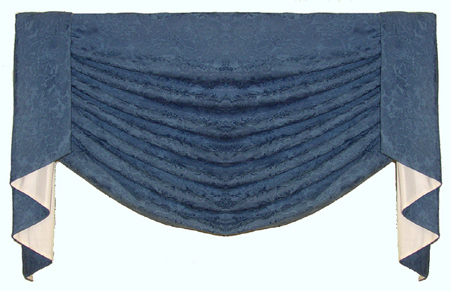
|
| |
|
|
Boxed Swags
This comtemporary
swag is unique in that it can completely stand alone. The swag folds wrap
the legs, finishing the treatment and covering the returns.
The basic pattern
shape is the same for this swag. Volume II teaches you the step-by-step
process to draw, cut and fabricate this swag with ease.
|
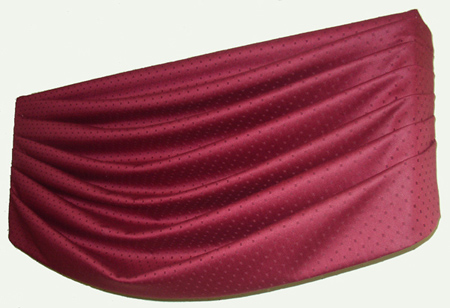
|
|
Arched/Slanted
Swags
The trick behind these
swags is cutting the pattern to follow the shape of the arched curve or
slant of a cathedral ceiling. Patterns are not readily available because
this swag must be cut to the exact shape of the finished treatment.
Volume II takes you
step by step through the process of designing the arched treatment, identifying
the arched styles and drawing the pattern.
You will be able to
design and draw patterns for beautiful arched and slanted swags of any
size and length.
|
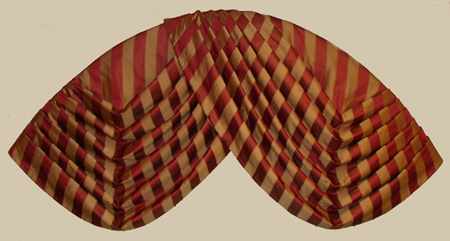 |
|
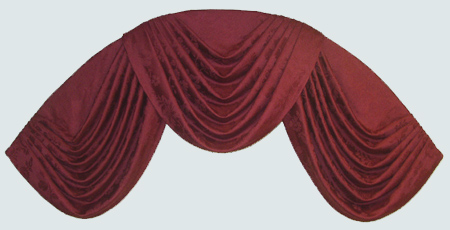
|
|
Asymmetrical Swags
An asymmetrical swag
is one in which the left side is not a mirror image of the right side.
This includes the raised/lifted swags on arched windows, the popular turban
swag and many many other asymmetrical designs.
Every asymmetrical
swag is simply a combination of two different swag styles and/or sizes.
Volume I and II have taught the steps to draw any swag style to any size
or shape. In this chapter, we teach you the process of identifying which
swag style(s) make up the asymmetrical swag and how to draw the asymmetrical
pattern.
Surprisingly, this
chapter in the book is the smallest. This is because drawing an asymmetrical
swag is simply the process of using all of the knowledge you already have
in drawing each of the six basic swag styles.
|
 |
|

|
| Nearly
200 pages of detailed information from designing the treatment to drafting
the pattern, troubleshooting, sewing and installing Austrian swags, Boxed
swags, Arched/Slanted swags and asymmetrical swags. Every step illustrated
with drawings and photos. The best part of this book are the worksheets
in the Appendix. Each worksheet guides you through the process of defining
and drawing the pattern for a specific swag style. You can copy and use
these worksheets in your workroom. |
|
Group Buys.
I offer discounts for group
buys. Contact me if you are
interested in placing an order for 10 or more books.

Read what workroom fabricators
and designers are saying about the Professional Workroom Handbook of Swags,
Volume 2:
"I am no longer anxiously
waiting, I have Ann K. Johnson's Handbook of Swags Volume II. I can attest that
it is the perfect addition to Volume I. This book will help you make any type
of asymmetrical swag in any combination of swag types. The book also coversTurban,
Boxed and Austrian Swags. This book is a "must have" for workroom
professionals. In addition to Volume I, by using the instructions in these books,
you will have the confidence that you can make any swag! Add profitability to
your workroom capabilities. This book is worth more than it's weight in gold."
Dean Fountain
|
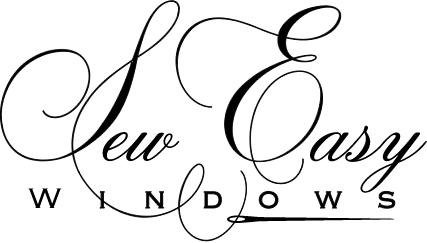
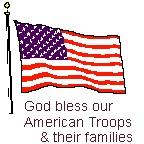


![]()